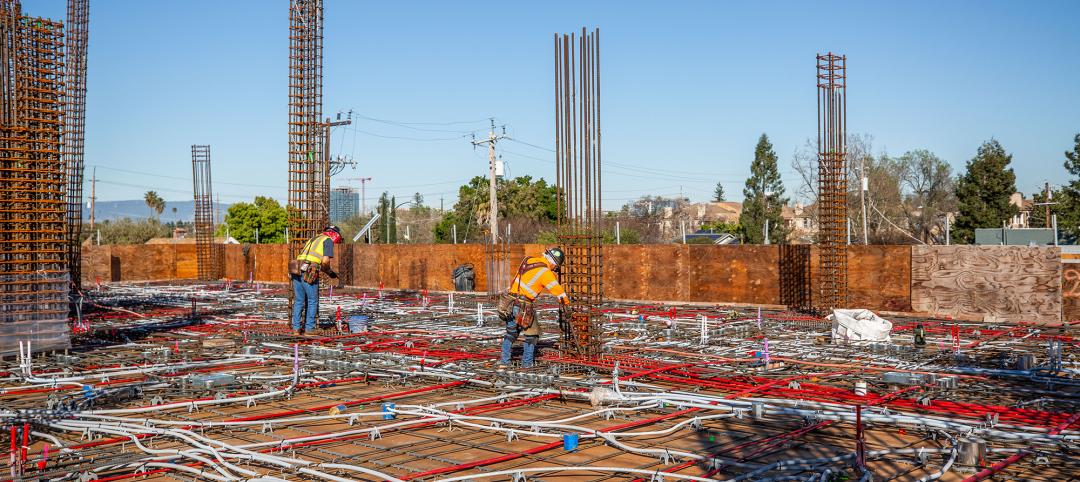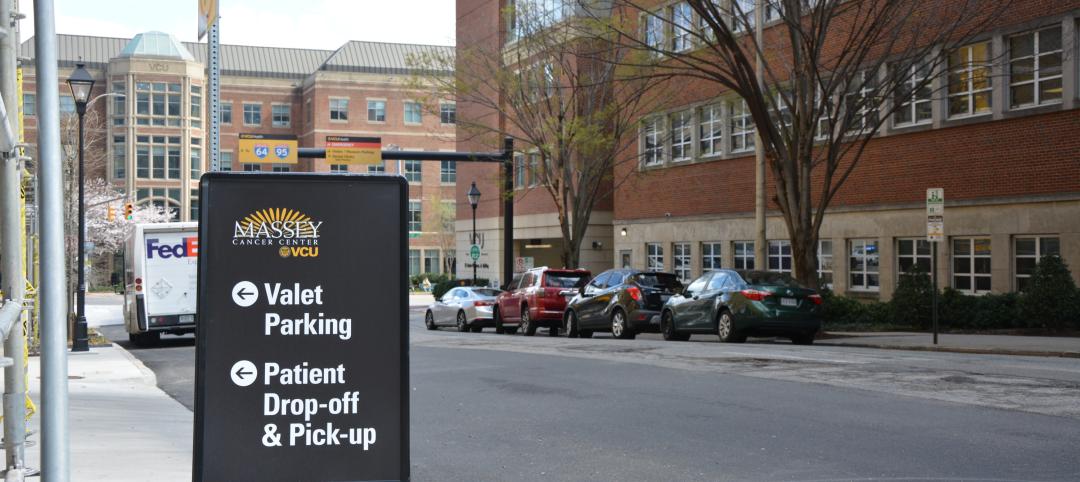Building occupants and users increasingly expect that environmental responsibility—conserving natural resources, providing healthy building environments, reducing operating costs—will be a top priority for building owners and project teams.
Most sustainable strategies are decided during project design. As the project moves into the construction phase, a few key construction efforts—erosion and pollution control, waste management, and indoor air quality management—are consistently implemented. But when it comes to sustainable practices during the construction phase itself, contractors are not always exploring all of the available opportunities.
Because most of the credits available within LEED BD+C rating systems are the responsibility of the building owner and design team, contractors usually are left with limited opportunity to directly control and achieve sustainability success. They are resigned to following the formulas for managing sustainability in line with prescribed LEED credits. The usual result: a narrowly focused sustainability effort on the construction site. Yet there are opportunities for contractors to go beyond LEED and achieve even greater outcomes by committing to healthier and more efficient job site practices.
LEARNING OBJECTIVES
After reading this article, you should be able to:
+ Discuss the opportunities a construction manager has to enhance sustainability during construction.
+ Explain how to structure a construction sustainability program to facilitate successful implementation on the job site.
+ List feasible and cost-appropriate activities to reduce environmental impact and carbon footprint during the construction process.
+ Describe the communication/education process the construction manager should implement to ensure success of the project’s sustainability efforts.
EDITOR’S NOTE
To earn 1.0 AIA CES learning units, study the article carefully and take the exam posted at www.BDCnetwork.com/
ContractorSustainability
At Robins & Morton, we have developed an internal program to examine opportunities to green every job site. Based on that experience, this course will review specific actions that contractors and construction managers can take to:
1. Generate a menu of feasible and cost-appropriate activities to reduce the project’s environmental impact and carbon footprint during construction
2. Enhance the project’s success by demonstrating a deep commitment to sustainability on the job site
These standards can guide building owners’ decision making on sustainability efforts during construction and what they should expect from their construction partners—and, conversely, what contractors should be expected to provide their clients.
FIRST THINGS FIRST: CREATE STANDARDS
To be sustainable during construction of every project, contractors must create a companywide policy to guide project teams and streamline the process. Such a policy hinges on: 1) developing an appropriate policy structure, 2) requiring realistic and feasible activities, and 3) creating buy-in and accountability.
To set the foundation, we recommend establishing a focus group of respected superintendents and project managers—individuals working on project sites full time, who understand where the sustainability opportunities lie and which of these could result in the greatest beneficial impact. They should be familiar with sustainability principles and have the experience and wisdom to judge the feasibility of newly proposed ideas. They must also be respected by others in the company, to gain buy-in at all levels of the firm.
The workshop should be led by a team member with considerable experience in environmental design and construction. This person will start the workshop with an overview of the general principles of sustainability, followed by a facilitated brainstorming session focused on those aspects of a project where the contractor makes decisions without extensive input or commitment from the owner or design team.
Our company has found three contractor-controlled areas that meet these criteria: 1) general requirements, such as temporary utilities and construction, 2) site controls and utilization, and 3) field office operation. From our experience, developing program standards using these criteria avoids ambiguity from other project team members’ roles and opinions and is easier to adopt.
Workshop subgroups should brainstorm actions within contractor-controlled criteria to: 1) minimize water usage, 2) save power and optimize fuel usage, 3) protect air quality and enhance human health, and 4) conserve natural resources and select healthier materials.
Next, analyze each idea not only by environmental benefit, but also by its impact on project requirements, including budget, schedule, safety, site constraints, labor, and equipment requirements. Activities or ideas that are determined to be cost-neutral, have no impact on safety or schedule, and produce minimal impact on site utilization, labor, and equipment requirements can likely be designated as mandatory for every project. Ideas where the environmental benefits outweigh the minimal impact on other project requirements may be designated as optional. Any activities or ideas that require a significant cost or impact on other project requirements should probably be eliminated.
Mandatory and optional activities should cultivate the company’s standard. They can be organized within the policy draft by:
• Area of environmental impact (water, energy, human health, or materials)
• Requirement level (optional or mandatory)
• Physical scope (construction site or job site office)
To ensure accountability and consistency, the project team should also be required to report to senior managers at construction start-up, at 50% construction completion, and at project closeout. We have also found it valuable to educate all individuals involved in the construction process about sustainability and the environmental efforts that will be implemented on site.
Construction job sites present numerous opportunities for environmental stewardship. Contractors must move beyond prescriptive methods and practices and embrace a commitment to develop a more dynamic program to greening every job site.
Contractors should work toward developing customized programs that target sustainable opportunities within the scope of their responsibilities, while considering cost, schedule, site utilization, and safety. Contractors must then commit to implementing, educating, and continuously improving their efforts.
Such a holistic approach to sustainability on the project site can produce a measurable reduction in the carbon footprint and environmental impacts of construction. It can also produce new benchmarks and replicable practices that can be shared across the industry. By documenting success and sharing knowledge, contractors can play a larger role in the green building movement.
Core Areas for Environmental Performance
on the Project Site
ENERGY CONSERVATION: HIGH PRIORITY
Minimizing energy usage is usually the highest priority in sustainable construction. The U.S. EPA estimates that 30% of energy used in the built environment is inefficiently used or wasted. Improving the energy efficiency of commercial and industrial buildings by 10% would result in a savings of $20 billion a year and prevent greenhouse gas emissions equivalent to those generated by 30 million vehicles.
Fueling generators to provide temporary power, powering a job site trailer, temporary lighting for the site and building, fueling earth-moving equipment, powering hand tools, and testing building equipment—all these activities consume fuel or electricity during construction.
TIPS FOR MINIMIZING WATER USAGE DURING CONSTRUCTION
• Recycle stormwater for dust control on site
• Install low-flow toilets and aerators at sinks in the job site trailer
• Implement a detailed stormwater pollution protection plan (SWPPP) to minimize water pollution and protect the neighboring community
• Collect rainwater for bootwash at the project trailer
TIPS FOR MINIMIZING ENERGY USAGE DURING CONSTRUCTION
• Hang temporary lighting separate from safety and egress lighting to shut down most lighting at the end of the workday
• Use LED lamps for temporary site lighting
• Orient the job site trailer to maximize daylighting
• Install a programmable thermostat in the trailer
With many construction projects running 24/7 to meet their schedules, energy use and monitoring becomes even more important—and the opportunities for savings even greater. An energy use analysis should be performed before construction begins to customize the project’s approach and actions for conservation.
Temporary lighting is one of the more demanding energy-consuming requirements during construction. Temporary lighting is necessary for safety and security and for interior work until the electrical contractor has installed fixtures and bulbs later in the schedule.
To reduce energy consumption, general contractors should work with the electrical subcontractor to ensure temporary lighting is hung to separate safety and egress lighting from all other temporary lighting. This should not require extra cost, just extra thought and coordination. At the end of each workday, most of the lighting can be turned off without affecting safety, egress, or security.
The use of LED lamps is highly recommended. The construction manager and electrical subcontractor should perform a cost analysis to determine if it makes sense to use LED lamps for temporary uses, since these lamps can be reused for future projects.
There are even opportunities to cut energy usage in your trailer or site office, just as you would in your corporate office. Selecting Energy Star appliances and equipment, shutting down lights and computers at the end of the workday, using LED lamps, and installing programmable thermostats are effective strategies. Wherever possible, trailers should be positioned in the shade in hotter climates and oriented to maximize daylighting and solar heat gain in cooler climates.
More-elaborate (and possibly more costly) strategies—use of solar-powered equipment and tools, diesel-electric or hybrid equipment, and renewable energy sources for temporary power—should be considered for their feasibility on a project-by-project basis.
WATER CONSERVATION AND MANAGEMENT
Building strategies like wet-curing and pressurizing fire protection systems require water usage during construction. Temporary activities—maintaining a clean job site, hydrating workers, and cleaning equipment and tools—also require water. Homing in on low-cost or cost-neutral activities is the easiest way to save water on your job.
Construction sites are constantly plagued by water connections and hoses that leak or are left running. By providing closable nozzles for all hoses and assigning a field employee to inspect connections and hoses daily, the construction manager can make an immediate, positive impact by eliminating unacceptable water wastage on the construction site. The cost will be marginal.
Another best practice: implement a stormwater pollution prevention plan. Most construction projects where a significant area of soil is disturbed must enforce an SWPPP. These plans are designed to minimize runoff from the site to protect nearby communities and water supplies from pollutants resulting from construction activities.
Preparing the plan and installing control techniques, such as silt fence stabilization, rock bag inlet protection, and geotextile erosion controls, will add some marginal costs, but can result in significant environmental and health benefits.
For sites that do not have temporary water sources, rainwater collection and reuse can yield measurable results. Water collected in rain barrels can be used at a tool or boot cleaning station. More sophisticated (and more costly) collection systems that can store and pump water may be appropriate on larger projects that require temporary irrigation or dusting-down of the site to protect air quality.
IMPROVING AIR QUALITY PROTECTION AND ENHANCING HUMAN HEALTH
It is the construction manager’s responsibility to support construction workers’ health by protecting job site air quality and enforcing healthy housekeeping standards. Typical sources of air pollution during construction include off-gassing of building materials, activities that create dust and particulates, emissions from fuel-powered equipment, and toxic cleaning products.
5 KEY ACTIONS FOR CONTRACTORS IN DEVELOPING A SUSTAINABILITY PLAN
• Focus on areas where the contractor can make the most impact and make decisions without extensive input or commitment from the owner or design team.
• Utilize key employees who have the experience and leadership necessary for analysis and implementation.
• Encourage the team to brainstorm without limitations; this will assist with identifying creative approaches and unique ideas.
• Develop analysis criteria that will minimize conflict or obstacles during the implementation process.
• Generate a plan to continuously review the program for improvement and update it at least annually.
CONDUCT SUSTAINABILITY EDUCATION DURING THE CONSTRUCTION PROCESS
• Assign an employee on site to enforce policy requirements and educate workers in weekly job site meetings
• Encourage the project owner to attend the weekly sustainability staff meetings
• Provide signage to reiterate project goals and update workers on progress
MAXIMIZE HUMAN HEALTH AND IMPROVE INDOOR AIR QUALITY DURING CONSTRUCTION
• Maintain a clean, organized site
• Hardscape temporary roads and pathways to minimize airborne dust
• Maintain a smoke-free job site
• Implement a no-idling policy to reduce emissions from equipment and vehicles
• Establish a detailed indoor air quality plan that utilizes sweeping compounds, temporary enclosures to isolate dust, and green cleaning products
• Identify opportunities to prefabricate building systems (e.g., headwalls, bathrooms, patient rooms)
• Implement a noise/vibration control plan to protect workers, neighbors, and nearby buildings from disturbance or damage
• Station an EMT on site to ensure quick response to any possible safety issues
• Provide a quality break area for workers
SELECT THE RIGHT MATERIALS DURING CONSTRUCTION
• Select cardboard product with recycled content for casework and flooring protection
• Use FSC-certified wood for blocking and temporary uses
• Utilize reusable fencing on site and reusable formwork for concrete structure
• Require vendors to reduce packaging for deliveries
• Implement a detailed waste management plan that diverts more than 80% of waste generated on site
• Salvage furniture for use in temporary on site office
• Install hand dryers within job site trailer to minimize use of paper towels
• Use tablet-stored documents to go paperless
It is important to develop an air quality plan for both indoor and outside activities. Such a plan must be tailored to each project. It can be developed to be cost-neutral or low-cost and can implement a full range of protection and confirmation testing activities.
Construction activities to protect indoor air quality:
- Utilize temporary enclosures to isolate work areas and limit migration of dust and airborne materials
- Use environmentally friendly cleaning products
- Utilize sweeping compound, when necessary
- Encourage workers to prefabricate as much work on the exterior of the building as possible
Construction activities to protect air quality on the exterior:
- Establish a no-idling policy for operated equipment, requiring equipment operators to shut off equipment after two minutes of idling
- Properly maintain equipment and construction vehicles to reduce emissions
- Dust down or hardscape pathways within the project site
- Enforce a no-smoking policy on the job site
Maintaining a clean and well-organized site and providing a quality break area for workers on site can also enhance worker well-being. For the temporary office or trailer, inspecting and cleaning air filters and providing rugs at the office entrance are simple, inexpensive, and effective ways to support worker health and improve air quality.
Protecting air quality and supporting human health should align with the goals of construction safety programs. Any cost-neutral or low-cost actions should be implemented. These activities should be a starting point for construction managers to consider and to generate other innovative ideas to protect air quality and improve human health on site.
MANAGING MATERIALS MORE EFFECTIVELY
A typical construction project deals with huge quantities of concrete, metal, wood, drywall, finishes, and all the concomitant packaging. Each material has to be purchased, handled, stored, installed, or disposed of. The constant influx of materials and their differing characteristics and requirements make it difficult for the contractor to green the total material handling process. Yet the variety and volume of materials provides a range of opportunities for improvement.
While contractors have less control over the materials that will be permanently installed in the building, they do have the ability and responsibility to select materials that are used temporarily on site. The contractor should review all materials that will be selected by the construction team to consider purchasing temporary materials that mirror LEED recommendations, such as reused materials, materials with recycled content, materials from within a 500-mile radius of the project, and materials with green certifications.
Materials purchased for construction techniques or as general requirements include temporary fencing, site signage, flooring or casework protection, and safety and scaffolding supplies. The contractor should consider purchasing reusable fencing in lieu of a one-time use fence. Signage should be designed to be reusable on future projects. Cardboard for flooring or casework protection should be ordered with 100% recycled content. FSC-certified wood can be selected for scaffolding or safety barriers.
The contractor should determine which materials can be selected more sustainably and at what, if any, additional cost. The contractor should purchase cost-neutral product alternatives and work with the owner to determine if there is an interest in paying a premium to select more sustainable construction materials.
The construction manager should also develop a plan to ensure appropriately timed material deliveries and suitable storing conditions for any materials on site. Accurately timed materials delivery minimizes the duration materials are on site before installation. If materials must be stored, they must be kept clean, dry, and away from other work activities. These recommendations are cost-neutral practices that will prevent materials from being damaged and becoming waste.
According to the EPA, building-related construction and demolition activities account for nearly 26% of non-industrial waste generation in the U.S., totaling about 160 million tons per year. Although 20-30% of building-related C&D debris is recovered for processing and recycling, the opportunity exists to recover more than twice this amount through better planning and management.
A construction waste management plan can minimize the waste generated on site and divert the waste that is generated away from landfill. Waste management plans have become a best practice for LEED projects, but they have yet to become a mandatory requirement for contractors on every project. This is another example of a contractor’s opportunity to manage materials sustainably on site and make a significant impact on the environment.
Development and implementation of an appropriate waste management program can result in waste diversion of 90% or more. Feasible diversion percentages rely heavily on the materials that will be used for the project, require a full commitment from on-site workers and waste haulers, and vary depending on the recycling and diversion options within the geographic region of the project.
Before any construction activities begin, the contractor should analyze the materials that will be used for the project and determine what types of material waste will be generated. The contractor can then locate local haulers and recyclers that can recycle the waste.
Contractors should also consider which of the waste materials can be reused on site—for example, concrete waste can be crushed and reused as subbase or temporary roadways. Developing an appropriate plan for the anticipated waste and verifying haulers’ and recyclers’ diversion processes before construction begins will smooth the coordination of the waste management plan and ensure maximum diversion from landfill.
There are opportunities in the temporary office or job site trailer to improve material selection as well. Batteries and electronics can be recycled. The team may be able to salvage or reuse office furniture instead of purchasing new furniture. Installing a water filtration system within the trailer will minimize waste generated from water bottles. Going paperless (or as paperless as possible) will save paper and minimize waste. The rapidly growing use of tablets and other portable digital devices is making this transition easier.
ADDRESSING COMMUNICATION AND EDUCATION
Successful execution of a construction sustainability program depends heavily on communication and education. The contractor’s team, subcontractors, trade workers, building owner’s staff, vendors, and suppliers must be aware of the goals and must commit to making the applicable improvements in their work practices.
The contractor should provide a list of the sustainable activities to be implemented, along with their requirements and benefits, and request feedback and confirmation from all players on the job site.
Continuous education and commitment can be accomplished by: 1) posting a list of the project’s sustainability rules in the break area or other prominent location, 2) reminding workers of the sustainability goals in weekly meetings, and 3) periodically announcing sustainability targets and environmental benefits the project has achieved.
Finally, it is extremely beneficial to designate a team member to act as on-site champion of the initiative. This individual should coordinate orientation and worker education and oversee implementation of the sustainable activities. The on-site coordinator should communicate up the chain as well. Monthly progress reports should be provided to the building owner and construction company managers, to reinforce the commitment to sustainability within the company culture and to communicate developing sustainability trends and any gaps within the sustainability program.
About the Author: Jackie Mustakas is Sustainability Manager at Robins & Morton. Based in the Orlando, Fla., office, she chairs the firm’s Sustainability Council. She holds an MS in building construction from the University of Florida.
Related Stories
Mass Timber | May 31, 2024
Mass timber a big part of Western Washington University’s net-zero ambitions
Western Washington University, in Bellingham, Wash., 90 miles from Seattle, is in the process of expanding its ABET-accredited programs for electrical engineering, computer engineering and science, and energy science. As part of that process, the university is building Kaiser Borsari Hall, the 54,000-sf new home for those academic disciplines that will include teaching labs, research labs, classrooms, collaborative spaces, and administrative offices.
Construction Costs | May 31, 2024
Despite challenges, 2024 construction material prices continue to stabilize
Gordian’s Q2 2024 Quarterly Construction Cost Insights Report indicates that supply chain issues notwithstanding, many commodities are exhibiting price normalization.
University Buildings | May 30, 2024
Washington University School of Medicine opens one of the world’s largest neuroscience research buildings
In St. Louis’ Cortex Innovation District, Washington University School of Medicine recently opened its new Jeffrey T. Fort Neuroscience Research Building. Designed by CannonDesign and Perkins&Will, the 11-story, 609,000-sf facility is one of the largest neuroscience buildings in the world.
Affordable Housing | May 30, 2024
General contractor’s keys to a successful affordable housing project
General contractors can have tremendous influence over a project’s success in terms of schedule, budget, and quality. However, to ensure a project is put on this path, there are a few factors that must be considered.
MFPRO+ New Projects | May 29, 2024
Two San Francisco multifamily high rises install onsite water recycling systems
Two high-rise apartment buildings in San Francisco have installed onsite water recycling systems that will reuse a total of 3.9 million gallons of wastewater annually. The recycled water will be used for toilet flushing, cooling towers, and landscape irrigation to significantly reduce water usage in both buildings.
Healthcare Facilities | May 28, 2024
Healthcare design: How to improve the parking experience for patients and families
Parking is likely a patient’s—and their families—first and last touch with a healthcare facility. As such, the arrival and departure parking experience can have a profound impact on their experience with the healthcare facility, writes Beth Bryan, PE, PTOE, PTP, STP2, Principal, Project Manager, Walter P Moore.
MFPRO+ News | May 28, 2024
ENERGY STAR NextGen Certification for New Homes and Apartments launched
The U.S. Environmental Protection Agency recently launched ENERGY STAR NextGen Certified Homes and Apartments, a voluntary certification program for new residential buildings. The program will increase national energy and emissions savings by accelerating the building industry’s adoption of advanced, energy-efficient technologies, according to an EPA news release.
Women in Design+Construction | May 28, 2024
Commerce Department launches Million Women in Construction Community Pledge
The U.S. Department of Commerce launched its Million Women in Construction Community Pledge this month to boost the ranks of women in construction companies. Federal investments are creating a construction boom that is increasing job opportunities for construction and trade workers.
Laboratories | May 24, 2024
The Department of Energy breaks ground on the Princeton Plasma Innovation Center
In Princeton, N.J., the U.S. Department of Energy’s Princeton Plasma Physics Laboratory (PPPL) has broken ground on the Princeton Plasma Innovation Center (PPIC), a state-of-the-art office and laboratory building. Designed and constructed by SmithGroup, the $109.7 million facility will provide space for research supporting PPPL’s expanded mission into microelectronics, quantum sensors and devices, and sustainability sciences.
MFPRO+ News | May 24, 2024
Austin, Texas, outlaws windowless bedrooms
Austin, Texas will no longer allow developers to build windowless bedrooms. For at least two decades, the city had permitted developers to build thousands of windowless bedrooms.


![The contractor’s role in promoting job site sustainability [AIA course] The contractor’s role in promoting job site sustainability [AIA course]](/sites/default/files/Screen%20Shot%202015-12-01%20at%209.07.23%20AM.png)














